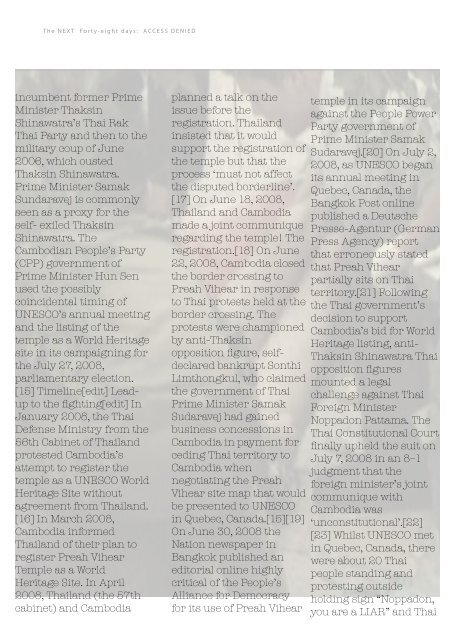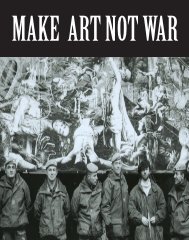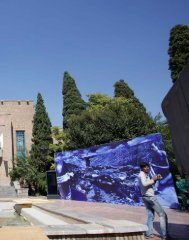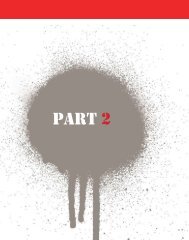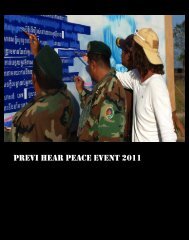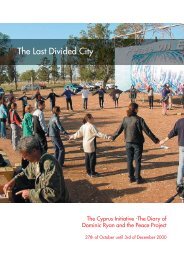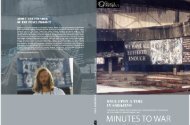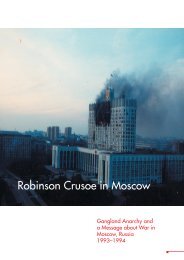You also want an ePaper? Increase the reach of your titles
YUMPU automatically turns print PDFs into web optimized ePapers that Google loves.
<strong>The</strong> NEXT Forty-eight days: ACCESS DENIED<br />
<strong>The</strong> NEXT Forty-eight days: ACCESS DENIED<br />
incumbent former Prime<br />
Minister Thaksin<br />
Shinawatra’s Thai Rak<br />
Thai Party and then to the<br />
military coup of June<br />
2006, which ousted<br />
Thaksin Shinawatra.<br />
Prime Minister Samak<br />
Sundaravej is commonly<br />
seen as a proxy for the<br />
self- exiled Thaksin<br />
Shinawatra. <strong>The</strong><br />
<strong>Cambodia</strong>n People’s Party<br />
(CPP) government of<br />
Prime Minister Hun Sen<br />
used the possibly<br />
coincidental timing of<br />
UNESCO’s annual meeting<br />
and the listing of the<br />
temple as a World Heritage<br />
site in its campaigning for<br />
the July 27, 2008,<br />
parliamentary election.<br />
[15] Timeline[edit] Leadup<br />
to the fighting[edit] In<br />
January 2008, the Thai<br />
Defense Ministry from the<br />
56th Cabinet of Thailand<br />
protested <strong>Cambodia</strong>’s<br />
attempt to register the<br />
temple as a UNESCO World<br />
Heritage Site without<br />
agreement from Thailand.<br />
[16] In March 2008,<br />
<strong>Cambodia</strong> informed<br />
Thailand of their plan to<br />
register Preah Vihear<br />
Temple as a World<br />
Heritage Site. In April<br />
2008, Thailand (the 57th<br />
cabinet) and <strong>Cambodia</strong><br />
planned a talk on the<br />
issue before the<br />
registration. Thailand<br />
insisted that it would<br />
support the registration of<br />
the temple but that the<br />
process ‘must not affect<br />
the disputed borderline’.<br />
[17] On June 18, 2008,<br />
Thailand and <strong>Cambodia</strong><br />
made a joint communique<br />
regarding the temple! <strong>The</strong><br />
registration.[18] On June<br />
22, 2008, <strong>Cambodia</strong> closed<br />
the border crossing to<br />
Preah Vihear in response<br />
to Thai protests held at the<br />
border crossing. <strong>The</strong><br />
protests were championed<br />
by anti-Thaksin<br />
opposition figure, selfdeclared<br />
bankrupt Sonthi<br />
Limthongkul, who claimed<br />
the government of Thai<br />
Prime Minister Samak<br />
Sudaravej had gained<br />
business concessions in<br />
<strong>Cambodia</strong> in payment for<br />
ceding Thai territory to<br />
<strong>Cambodia</strong> when<br />
negotiating the Preah<br />
Vihear site map that would<br />
be presented to UNESCO<br />
in Quebec, Canada.[15][19]<br />
On June 30, 2008 the<br />
Nation newspaper in<br />
Bangkok published an<br />
editorial online highly<br />
critical of the People’s<br />
Alliance for Democracy<br />
for its use of Preah Vihear<br />
temple in its campaign<br />
against the People Power<br />
Party government of<br />
Prime Minister Samak<br />
Sudaravej.[20] On July 2,<br />
2008, as UNESCO began<br />
its annual meeting in<br />
Quebec, Canada, the<br />
Bangkok Post online<br />
published a Deutsche<br />
Presse-Agentur (German<br />
Press Agency) report<br />
that erroneously stated<br />
that Preah Vihear<br />
partially sits on Thai<br />
territory.[21] Following<br />
the Thai government’s<br />
decision to support<br />
<strong>Cambodia</strong>’s bid for World<br />
Heritage listing, anti-<br />
Thaksin Shinawatra Thai<br />
opposition figures<br />
mounted a legal<br />
challenge against Thai<br />
Foreign Minister<br />
Noppadon Pattama. <strong>The</strong><br />
Thai Constitutional Court<br />
finally upheld the suit on<br />
July 7, 2008 in an 8–1<br />
judgment that the<br />
foreign minister’s joint<br />
communique with<br />
<strong>Cambodia</strong> was<br />
‘unconstitutional’.[22]<br />
[23] Whilst UNESCO met<br />
in Quebec, Canada, there<br />
were about 20 Thai<br />
people standing and<br />
protesting outside<br />
holding sign “Noppadon,<br />
you are a LIAR” and Thai<br />
flags. On July 8, 2008,<br />
thousands of Phnom Penh<br />
residents marched through<br />
the streets in celebration of<br />
the inscription of Preah<br />
Vihear temple by UNESCO.<br />
On the same day, the<br />
Municipality of Phnom<br />
Penh held an evening<br />
outdoor concert at Wat<br />
Phnom to celebrate the<br />
inscription of Preah Vihear<br />
temple by UNESCO earlier<br />
in the day. <strong>The</strong> concert was<br />
nationally broadcast on<br />
CTN, emceed by <strong>Cambodia</strong>’s<br />
biggest television star and<br />
featured traditional Khmer<br />
performances as well as a<br />
fireworks display. Despite<br />
persistent rain, thousands<br />
of <strong>Cambodia</strong>ns attended. On<br />
July 10, 2008, Thai Foreign<br />
Minister Nappadon Pattama<br />
resigned over the listing of<br />
Preah Vihear by UNESCO.<br />
His resignation followed the<br />
8-1 judgment by the Thai<br />
Constitutional Court that he<br />
had violated Article 190 of<br />
Thailand’s 2007<br />
Constitution, which calls for<br />
a public debate and Cabinetlevel<br />
approval before any<br />
such authorization can take<br />
place. On July 14, 2008,<br />
8,000 <strong>Cambodia</strong>ns filled<br />
Phnom Penh’s Olympic<br />
Stadium Indoor Arena for a<br />
concert hosted by Deputy<br />
Prime Minister Sok An and<br />
simulcast on Bayon<br />
Television. Sok An had just<br />
returned from UNESCO’s<br />
annual conference in Quebec,<br />
Canada, where Preah Vihear<br />
was inscribed as a World<br />
Heritage site.[25] On July 15,<br />
2008, cross- border tensions<br />
flared after <strong>Cambodia</strong>n<br />
authorities arrested three<br />
Thai nationals who had<br />
attempted to plant the Thai<br />
flag near the temple. Several<br />
dozen Thai soldiers were<br />
claimed by <strong>Cambodia</strong>n to<br />
have subsequently crossed<br />
the border. One Thai soldier<br />
lost his leg to a land-mine<br />
detonation.[26][27][28]<br />
Thailand maintains that its<br />
troops are deployed to protect<br />
its sovereignty and ensure<br />
that any protests by Thais<br />
near the temple remain<br />
orderly, although a<br />
senior Thai military<br />
official acknowledged<br />
that the troops were on<br />
“disputed” ground. On<br />
July 16, 2008, Thailand<br />
increased the number of<br />
troops stationed in the<br />
border region[29]<br />
adjacent to Preah Vihear<br />
temple. On July 17, 2008,<br />
the total number of<br />
troops at the temple<br />
increased to over 1,000,<br />
with some of the 400<br />
Thai troops in the area<br />
occupying a Buddhist<br />
pagoda near the temple<br />
and claimed by<br />
<strong>Cambodia</strong>. Thai forces<br />
have denied they are<br />
inside <strong>Cambodia</strong>n<br />
territory. In a letter to<br />
the Thai Prime Minister,<br />
<strong>Cambodia</strong>n Prime<br />
Minister Hun Sen called<br />
for the immediate<br />
withdrawal of Thai<br />
troops and protesters<br />
from the area. On July<br />
18, 2008, the Thai<br />
government handed<br />
<strong>Cambodia</strong> a letter from<br />
Prime Minister Samak<br />
Sundaravej insisting<br />
Thai troops are deployed<br />
on Thai soil. In a letter<br />
to Hun Sen, the Thai PM<br />
said <strong>Cambodia</strong>n troops<br />
and buildings on the<br />
disputed 4.6 km2 (1.8 sq<br />
mi) area were a


